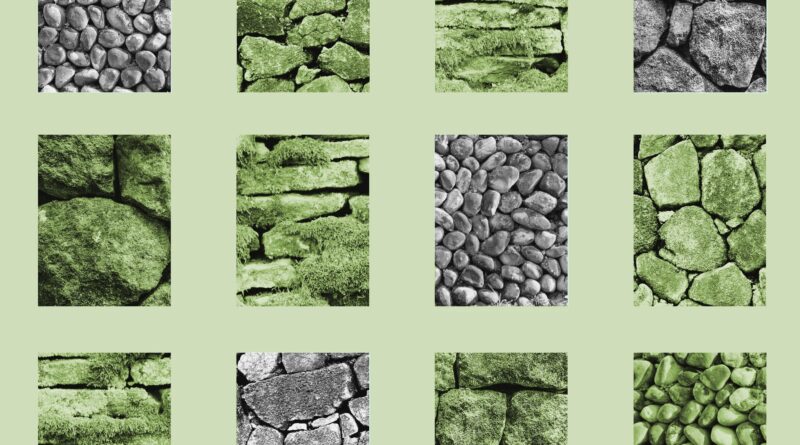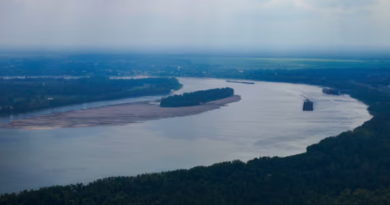The Simple, Ancient Idea That Can Replace Concrete Walls
A dry stone wall is a purposeful pile of rocks, held in place by friction and gravity rather than mortar. It’s one of the oldest building methods known to mankind, used over millennia to construct buildings, wind breaks, and dikes, to mark borders and create monuments, and to keep livestock penned in and nuisance animals hemmed out. In rural Japan, where I live, stone-retaining walls shape a country that’s 80 percent mountainous into livable and farmable land.
To get into town from my home, I walk past century-old stone walls. The rocks are shaded velvety green by moss, and plumes of ferns spring from crevices with starry pink flowers hovering above. These walls carve out spaces for roads and houses and define irregular terraced rice paddies farther up in the mountains.
But closer to town, stone walls give way to walls made of concrete, which has largely replaced stone as the defining material of Japan’s rural infrastructure. Is that because concrete construction is cheaper, stronger, or faster? Not really. Reviving dry stone walling would be better for the environment, as well as preserve aesthetically and culturally valuable scenery. But building more stone walls would mean relying on traditional craftsmanship over modern engineering.
I thought of stone walling as an expensive antique building method until I spoke with Reo Kaneko, a civil engineer who, over the past 14 years, has become an advocate for this time-tested craft. Not every stone wall is like the tidy, geometrically perfect type built around castles. For farmers and ordinary people, stone walls had to be “fast, cheap, and strong,” Kaneko told me when we first met.
He’d traveled here, to Yamanaka Onsen, to rebuild a wall keeping the slope below a 100-year-old farmhouse from eroding into the river. The carpenter who is helping me restore my own old farmhouse took me to see the process. Kaneko began by disassembling the original wall, at least as old as the house, which had gradually buckled under pressure from heavy rain runoff and snowmelt. The original stones—as big as watermelons—became the material for the new construction, a tiered wall terracing several meters of the slope. With two other men, Kaneko stacked the large stones, filling the gaps between them with smaller rocks and pouring buckets of gravel into an intentional space between the wall and the hillside to help with drainage and reduce pressure on the wall.
Kaneko runs the Dry Stone Walling School of Japan with Junko Sanada, the professor who first introduced him to dry stone walling when he was an undergraduate engineering student. Sanada brought a group of students to help rebuild walls in a mountain village in Tokushima prefecture, under the tutelage of a local craftsman. The transformation of a pile of rubble into a sturdy retaining wall so impressed Kaneko that he wrote his master’s thesis on the village and its techniques, and after a few years at a construction company, he left his job to focus on stone walling.
Most people in Japan stopped using these techniques, Kaneko told me, “simply because they did not fit with modern civil-engineering systems.” In the period of rapid industrialization after the U.S. pushed Japan to open its borders in 1854, ending centuries of isolationism and near self-sufficiency, Western equaled modern. A 1908 Japanese civil-engineering textbook describes stone walling as an “extremely crude construction method.” Concrete, by contrast, was all the rage from Paris to Cincinnati; it is smooth and uniform and can be poured into almost any shape. A wall made of concrete can be engineered mathematically and then executed by less skilled workers. In Japan, that made concrete especially appealing after World War II, in the rush to rebuild infrastructure and homes for millions of people made homeless by widespread firebombings and two atomic bombs.
Concrete is now the most widely used construction material on Earth, and Japan has been particularly enthusiastic in its adoption—to fortify not only infrastructure but the economy with large public-works projects. Tetrapods and other concrete barriers sweep the coastline, and rivers flowing through populated areas are frequently banked in concrete. Concrete is also one of the more intractable climate problems. It is responsible for 9 percent of global industrial water withdrawals, and the cement that goes into making it contributes up to 8 percent of global carbon dioxide emission. This is partly because of the sheer volume of concrete being used and partly because of the energy intensity and chemical reactions involved in producing cement, the key ingredient in concrete.
We now know that the race toward modernization—even with all its benefits to efficiency and comfort—has also been a race toward irreversible, catastrophic climate change. New technologies will help (lower-carbon concrete does now exist, though it’s been slow to catch on), but ancient technologies such as stone walling can too. Concrete isn’t going away, but particularly in places defined by their steep landscapes, stone is a viable alternative for building retaining walls and water courses.
A concrete retaining wall can last about 50 to 100 years, after which the degraded material must be hauled away for recycling or disposal and fresh concrete manufactured to rebuild. By some estimates, producing concrete releases nearly a pound of CO2 per pound of usable material; under the right conditions, stone for a wall can be gathered on-site or quarried nearby. The rocks can be used without being cut into uniform shapes, limiting waste. And the life span of a dry stone wall is potentially hundreds of years, in part because a well-built wall can shift to some extent without buckling when it freezes and thaws or even in an earthquake. When a stone wall finally collapses, the stones can be collected and reused or left to tumble into the surrounding fields or woodlands.
In 2018, UNESCO inscribed dry stone walling as an Intangible Cultural Heritage of Humanity, stating that “the technique exemplifies a harmonious relationship between human beings and nature.” When building a dry stone wall, Kaneko told me, you have to work with the contours of the land and irregularities of each stone. John New, the chair of the West of Scotland Dry Stone Walling Association, told me that “when you’re building a stone wall, you become part of the environment. Brown hares will just come up and stop and watch you.” Deer too. Almost as soon as it’s built, a stone wall is inhabited by insects—a key indicator of biodiversity—and small animals such as voles, chipmunks, and wrens. In China, researchers have documented the remarkable diversity of plants thriving on ancient stone walls—even in urban environments.
In rocky regions around the world, groups are working to preserve and promote the craft of dry stone walling, touting the benefits to biodiversity and low carbon footprint. These are inherently local efforts because building with stone makes the most sense when it can be sourced locally. (In the past, farmers used stone unearthed while clearing the very fields they needed to terrace or fence.) In Scotland, for example, trucking in material for a stock fence from far away could cost upwards of $5,000, New said. The most ambitious recent dry-stone-walling projects, such as the multimillion-dollar effort to restore the stone walls of Italy’s Cinque Terre, are in service of historical preservation. But Stone Walls for Life, the EU-funded project organizing the Cinque Terre restoration effort, argues that the walls strengthen resilience to climate change, too, by improving drainage and preventing landslides. They plan to replicate this kind of undertaking around the EU.
In Japan, Kaneko told me, most of the people who still know how to build simple utilitarian stone walls are in their 80s. In the past, if a stone wall along a rice paddy or road collapsed, the community would gather to repair it. This collective experience was key. When I met him again at a Kyoto café (in the concrete Kyoto International Conference Center, near a concrete-encased river), Kaneko told me about a 1919 Journal of Engineering article that emphasized the importance of human skill and discretion rather than objective numbers in stone-wall buildings. Although perfecting the craft of stone walling takes a lifetime, Kaneko said that an amateur with no formal engineering experience can learn the basics in about four days. Through workshops all over the country, he and Sanada teach people to place stones with the long side angled down into the slope, to make sure that each large stone touches at least two others, and to fill behind the large stones with small rocks or gravel as they build. There have been attempts to standardize and mechanize dry stone walling, using, for example, software and a robotic excavator. But Kaneko says that in many cases, the sites where he works are too narrow or steep for a machine to access. To him, stone walling’s reliance on manpower instead of machine power and passed-down knowledge instead of equations is part of its value. “I like the very wild, dry stone walls,” he told me.
Embracing those qualities, though, requires trust and experience. In July, Kaneko traveled to the town of Genkai, on Japan’s southern island of Kyushu, to repair the walls at Hamanoura Tanada, a scenic and historic site where nearly 300 small terraced rice paddies chisel the dramatic slopes above an inlet of the Genkai Sea. A few years ago, the town’s planning and commerce division invited Kaneko to teach five local construction companies how to build dry stone walls so they could preserve the traditional scenery. But even with that training, none of them was willing to take on rebuilding stone walls. It’s seen as a labor-intensive and risky job, Kaneko said. Companies that use concrete can reliably calculate the strength of their walls, but it’s nearly impossible to estimate the engineered strength of any particular dry stone wall. Although villages and private landowners can choose stone over concrete, there have been no mainstream attempts to return to dry stone walling for major new public-works projects in Japan, Kaneko told me. In the United States, most landscaping walls shorter than three or four feet don’t need to be permitted, Alan Kren, a structural engineer at Rutherford + Chekene, told me. Building stone walls on any larger scale would likely require new standards for using these old techniques.
Each stone wall that does get built eschews practices that exacerbate global warming and habitat destruction in favor of ones that enhance resilience. I would be heartbroken if the stone walls on my walk into town—alive with a wild vertical garden of ferns and flowers—were replaced by stagnant concrete. As climate change makes flooding and landslides more frequent and extreme, we will have to build more retaining walls and levees, and in plenty of cases, we have a choice. We could build them out of concrete, contributing to the problem we’re trying to ameliorate. Or we could build them out of stone, using an idea from the past to help shore up our future.
Source: theatlantic.com




